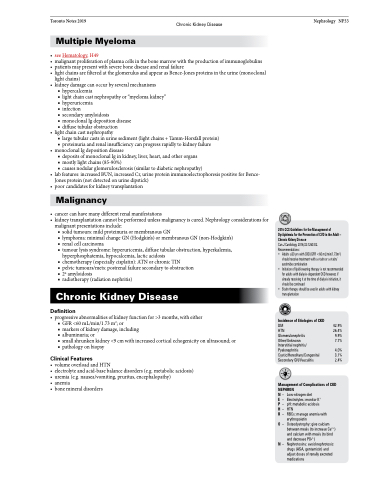Page 733 - TNFlipTest
P. 733
Toronto Notes 2019 Chronic Kidney Disease Multiple Myeloma
• seeHematology,H49
• malignantproliferationofplasmacellsinthebonemarrowwiththeproductionofimmunoglobulins
• patientsmaypresentwithseverebonediseaseandrenalfailure
• lightchainsarefilteredattheglomerulusandappearasBence-Jonesproteinsintheurine(monoclonal
light chains)
• kidneydamagecanoccurbyseveralmechanisms
■ hypercalcemia
■ light chain cast nephropathy or “myeloma kidney” ■ hyperuricemia
■ infection
■ secondary amyloidosis
■ monoclonal Ig deposition disease
■ diffuse tubular obstruction
• lightchaincastnephropathy
■ large tubular casts in urine sediment (light chains + Tamm-Horsfall protein) ■ proteinuria and renal insufficiency can progress rapidly to kidney failure
• monoclonalIgdepositiondisease
■ deposits of monoclonal Ig in kidney, liver, heart, and other organs
■ mostly light chains (85-90%)
■ causes nodular glomerulosclerosis (similar to diabetic nephropathy)
• labfeatures:increasedBUN,increasedCr,urineproteinimmunoelectrophoresispositiveforBence- Jones protein (not detected on urine dipstick)
• poorcandidatesforkidneytransplantation
Malignancy
• cancercanhavemanydifferentrenalmanifestations
• kidneytransplantationcannotbeperformedunlessmalignancyiscured.Nephrologyconsiderationsfor
malignant presentations include:
■ solid tumours: mild proteinuria or membranous GN
■ lymphoma: minimal change GN (Hodgkin’s) or membranous GN (non-Hodgkin’s) ■ renal cell carcinoma
■ tumour lysis syndrome: hyperuricemia, diffuse tubular obstruction, hyperkalemia,
hyperphosphatemia, hypocalcemia, lactic acidosis
■ chemotherapy (especially cisplatin): ATN or chronic TIN
■ pelvic tumours/mets: postrenal failure secondary to obstruction ■ 2o amyloidosis
■ radiotherapy (radiation nephritis)
Chronic Kidney Disease
Definition
• progressiveabnormalitiesofkidneyfunctionfor>3months,witheither ■ GFR <60 mL/min/1.73 m2; or
■ markers of kidney damage, including
■ albuminuria; or
■ small shrunken kidney <9 cm with increased cortical echogenicity on ultrasound; or ■ pathology on biopsy
Clinical Features
• volumeoverloadandHTN
• electrolyteandacid-basebalancedisorders(e.g.metabolicacidosis) • uremia(e.g.nausea/vomiting,pruritus,encephalopathy)
• anemia
• bonemineraldisorders
Nephrology NP33
2016 CCS Guidelines for the Management of Dyslipidemia for the Prevention of CVD in the Adult – Chronic Kidney Disease
Can J Cardiology 2016;32:1263-82.
Recommendations:
• Adults≥50yrswithCKD(GFR<60mL/min/1.73m2)
should receive treatment with a statin or a statin/
ezetimibe combination
• Initiationoflipid-loweringtherapyisnotrecommended
for adults with dialysis-dependent CKD however, if already receiving it at the time of dialysis initiation, it should be continued
• Statintherapyshouldbeusedinadultswithkidney transplantation
Incidence of Etiologies of CKD
DM 42.9% HTN 26.4% Glomerulonephritis 9.9% Other/Unknown 7.7% Interstitial nephritis/
Pyelonephritis 4.0% Cystic/Hereditary/Congenital 3.1% Secondary GN/Vasculitis 2.4%
Management of Complications of CKD NEPHRON
N– E – P – H – R–
O–
N–
Low-nitrogendiet Electrolytes:monitorK+ pH:metabolicacidosis
HTN
RBCs:manageanemiawith erythropoietin Osteodystrophy:givecalcium between meals (to increase Ca2+) and calcium with meals (to bind and decrease PO43-) Nephrotoxins:avoidnephrotoxic drugs (ASA, gentamicin) and adjust doses of renally excreted medications


